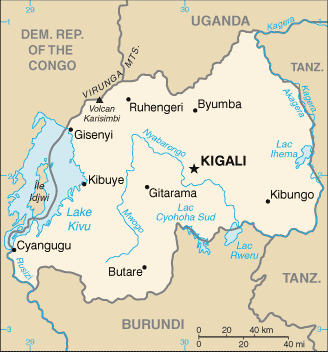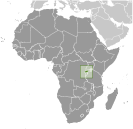
|
|
Advertisements:
EconomyEconomy - overview
Rwanda is a poor rural country with about 90% of the population engaged in (mainly subsistence) agriculture and some mineral and agro-processing. Tourism, minerals, coffee and tea are Rwanda's main sources of foreign exchange. Minerals exports declined 40% in 2009-10 due to the global economic downturn. The 1994 genocide decimated Rwanda's fragile economic base, severely impoverished the population, particularly women, and temporarily stalled the country's ability to attract private and external investment. However, Rwanda has made substantial progress in stabilizing and rehabilitating its economy to pre-1994 levels. GDP has rebounded with an average annual growth of 7%-8% since 2003 and inflation has been reduced to single digits. Nonetheless, a significant percent of the population still live below the official poverty line. Despite Rwanda's fertile ecosystem, food production often does not keep pace with demand, requiring food imports. Rwanda continues to receive substantial aid money and obtained IMF-World Bank Heavily Indebted Poor Country (HIPC) initiative debt relief in 2005-06. In recognition of Rwanda's successful management of its macro economy, in 2010, the IMF graduated Rwanda to a Policy Support Instrument (PSI). Rwanda also received a Millennium Challenge Threshold Program in 2008. Africa's most densely populated country is trying to overcome the limitations of its small, landlocked economy by leveraging regional trade. Rwanda joined the East African Community and is aligning its budget, trade, and immigration policies with its regional partners. The government has embraced an expansionary fiscal policy to reduce poverty by improving education, infrastructure, and foreign and domestic investment and pursuing market-oriented reforms. Energy shortages, instability in neighboring states, and lack of adequate transportation linkages to other countries continue to handicap private sector growth. The Rwandan government is seeking to become regional leader in information and communication technologies. In 2010, Rwanda neared completion of the first modern Special Economic Zone (SEZ) in Kigali. The SEZ seeks to attract investment in all sectors, but specifically in agribusiness, information and communications technologies, trade and logistics, mining, and construction. The global downturn hurt export demand and tourism, but economic growth is recovering, driven in large part by the services sector, and inflation has been contained. On the back of this growth, government is gradually ending its fiscal stimulus policy while protecting aid to the poor. In 2011 rises in global food and fuel prices increased inflation in Rwanda from 1% in January to more than 7% in October. Gdp (purchasing power parity) World Ranking: 141
$13.86 billion (2011 est.)
$12.74 billion (2010 est.) $11.85 billion (2009 est.) Note Data are in 2011 US dollars Gdp (official exchange rate)
$6.179 billion (2011 est.)
Gdp - real growth rate World Ranking: 13
8.8% (2011 est.)
7.5% (2010 est.) 4.1% (2009 est.) Gdp - per capita (ppp) World Ranking: 202
$1,400 (2011 est.)
$1,300 (2010 est.) $1,200 (2009 est.) Note Data are in 2011 US dollars Gdp - composition by sector
Agriculture 33%
Industry 13.9% Services 53.1% (2011 est.) Labor force World Ranking: 85
4.446 million (2007)
Labor force - by occupation
Agriculture 90%
Industry and services 10% (2000) Unemployment rate
NA%
Population below poverty line
44.9% (2011 est.)
Household income or consumption by percentage share
Lowest 10% 2.1%
Highest 10% 43.2% (2011 est.) Distribution of family income - gini index World Ranking: 33
46.8 (2000)
28.9 (1985) Investment (gross fixed) World Ranking: 64
22.2% of GDP (2011 est.)
Budget
Revenues $1.436 billion
Expenditures $1.637 billion (2011 est.) Taxes and other revenues World Ranking: 134
23.2% of GDP (2011 est.)
Budget surplus (+) or deficit (-) World Ranking: 107
-3.3% of GDP (2011 est.)
Public debt World Ranking: 114
24.6% of GDP
22.7% of GDP Inflation rate (consumer prices) World Ranking: 93
3.9% (2011 est.)
2.3% (2010 est.) Central bank discount rate World Ranking: 22
7.75% (31 December 2010 est.)
11.25% (31 December 2008) Commercial bank prime lending rate World Ranking: 35
16% (31 December 2011 est.)
16% (31 December 2010 est.) Stock of narrow money World Ranking: 157
$592.2 million (31 December 2011 est.) $529.1 million (31 December 2010 est.) Stock of broad money World Ranking: 158
$1.29 billion (31 December 2011 est.) $1.124 billion (31 December 2010 est.) Stock of domestic credit World Ranking: 166
$605.4 million (31 December 2011 est.) $538.1 million (31 December 2010 est.) Market value of publicly traded shares
$NA
Agriculture - products
Coffee, tea, pyrethrum (insecticide made from chrysanthemums), bananas, beans, sorghum, potatoes; livestock Industries
Cement, agricultural products, small-scale beverages, soap, furniture, shoes, plastic goods, textiles, cigarettes Industrial production growth rate World Ranking: 34
7.5% (2010 est.)
Electricity - production World Ranking: 181
160 million kWh (2008 est.)
Electricity - consumption World Ranking: 176
236.8 million kWh (2008 est.)
Electricity - exports
2 million kWh (2008 est.)
Electricity - imports
88 million kWh (2008 est.)
Oil - production World Ranking: 127
0 bbl/day (2010 est.)
Oil - consumption World Ranking: 163
6,000 bbl/day (2010 est.)
Oil - exports World Ranking: 189
0 bbl/day (2009 est.)
Oil - imports World Ranking: 153
5,105 bbl/day (2009 est.)
Oil - proved reserves World Ranking: 180
0 bbl (1 January 2011 est.)
Natural gas - production World Ranking: 114
0 cu m (2009 est.)
Natural gas - consumption World Ranking: 120
0 cu m (2009 est.)
Natural gas - exports World Ranking: 165
0 cu m (2009 est.)
Natural gas - imports World Ranking: 115
0 cu m (2009 est.)
Natural gas - proved reserves World Ranking: 65
56.63 billion cu m (1 January 2011 est.) Current account balance World Ranking: 113
-$710.2 million (2011 est.)
-$421 million (2010 est.) Exports World Ranking: 179
$372.9 million (2011 est.)
$297 million (2010 est.) Exports - commodities
Coffee, tea, hides, tin ore
Exports - partners
Kenya 30.1%, China 13.5%, Democratic Republic of the Congo 12%, Malaysia 8.8%, US 5.6%, Swaziland 4.8% (2011) Imports World Ranking: 171
$1.372 billion (2011 est.)
$1.084 billion (2010 est.) Imports - commodities
Foodstuffs, machinery and equipment, steel, petroleum products, cement and construction material Imports - partners
Kenya 18.1%, Uganda 16.4%, US 10.4%, UAE 8.8%, China 5.7%, Tanzania 5.3% (2011) Reserves of foreign exchange and gold World Ranking: 132
$955 million (31 December 2011 est.) $812.8 million (31 December 2010 est.) Debt - external
$NA (31 December 2010 est.)
$747 million (31 December 2009 est.) Stock of direct foreign investment - at home World Ranking: 94
$NA $507.3 million (31 December 2011 est.) $435 millionStock of direct foreign investment - abroad World Ranking: 88
$13 million
$13 million Exchange rates
Rwandan francs (RWF) per US dollar - 600.31 (2011 est.)583.13 (2010 est.) 568.18 (2009) 550 (2008) 585 (2007) Fiscal year
Calendar year
Comments
Add a new comment: |
Advertisement
Members area
Rwanda (Kigali):
 
GPS points from Rwanda (Kigali)
|
||||||||

 In 1959, three years before independence from Belgium, the majority ethnic group, the Hutus, overthrew the ruling Tutsi king. Over the next several years, thousands of Tutsis were killed, and some 150,000 driven into exile in neighboring countries. The children of these exiles later formed a rebel group, the Rwandan Patriotic Front (RPF), and began a civil war in 1990. The war, along with several political and economic upheavals, exacerbated ethnic tensions, culminating in April 1994 in a state-orchestrated genocide, in which Rwandans killed up to a million of their fellow citizens, including approximately three-quarters of the Tutsi population. The genocide ended later that same year when the predominantly Tutsi RPF, operating out of Uganda and northern Rwanda, defeated the national army and Hutu militias, and established an RPF-led government of national unity. Approximately 2 million Hutu refugees - many fearing Tutsi retribution - fled to neighboring Burundi, Tanzania, Uganda, and Zaire. Since then, most of the refugees have returned to Rwanda, but several thousand remained in the neighboring Democratic Republic of the Congo (DRC, the former Zaire) and formed an extremist insurgency bent on retaking Rwanda, much as the RPF tried in 1990. Rwanda held its first local elections in 1999 and its first post-genocide presidential and legislative elections in 2003. Rwanda in 2009 staged a joint military operation with the Congolese Army in DRC to rout out the Hutu extremist insurgency there and Kigali and Kinshasa restored diplomatic relations. Rwanda also joined the Commonwealth in late 2009.
In 1959, three years before independence from Belgium, the majority ethnic group, the Hutus, overthrew the ruling Tutsi king. Over the next several years, thousands of Tutsis were killed, and some 150,000 driven into exile in neighboring countries. The children of these exiles later formed a rebel group, the Rwandan Patriotic Front (RPF), and began a civil war in 1990. The war, along with several political and economic upheavals, exacerbated ethnic tensions, culminating in April 1994 in a state-orchestrated genocide, in which Rwandans killed up to a million of their fellow citizens, including approximately three-quarters of the Tutsi population. The genocide ended later that same year when the predominantly Tutsi RPF, operating out of Uganda and northern Rwanda, defeated the national army and Hutu militias, and established an RPF-led government of national unity. Approximately 2 million Hutu refugees - many fearing Tutsi retribution - fled to neighboring Burundi, Tanzania, Uganda, and Zaire. Since then, most of the refugees have returned to Rwanda, but several thousand remained in the neighboring Democratic Republic of the Congo (DRC, the former Zaire) and formed an extremist insurgency bent on retaking Rwanda, much as the RPF tried in 1990. Rwanda held its first local elections in 1999 and its first post-genocide presidential and legislative elections in 2003. Rwanda in 2009 staged a joint military operation with the Congolese Army in DRC to rout out the Hutu extremist insurgency there and Kigali and Kinshasa restored diplomatic relations. Rwanda also joined the Commonwealth in late 2009.